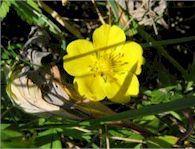|

Silverwood |
Two "Potentillas" occur among our common native plants, and possess certain curative virtues (as popularly supposed), the Silverweed and the Cinquefoil. They belong to the Rose tribe, and grow abundantly on our roadsides, being useful as mild astringents.
The Potentilla anserina (Silverweed) is found, as its adjective suggests, where geese are put to feed.
Country folk often call it Cramp Weed: but it is more generally known as Goose Tansy, or Goose Gray, because it is a spurious Tansy, fit only for a goose; or, perhaps, because eaten by geese. Other names for the herb are Silvery Cinquefoil, and Moorgrass. It occurs especially on clay soils, being |
recognized by its pinnate white silvery leaves, and its conspicuous golden flowers.
In Yorkshire the roots are known as "moors," which boys dig up and eat in the winter; whilst swine will also devour them greedily. They have then a sweet taste like parsnips. In Scotland, also, they are eaten roasted, or boiled; and sometimes, in hard seasons, when other provisions were scanty, these roots have been known to support the inhabitants of certain islands for months together.
Both the roots and the leaves are mildly astringent; so that their infusion helps to stay diarrhea, and the fluxes of women; making also with honey a useful gargle. The leaf is of an exquisitely beautiful shape, and may be seen carved on the head of many an old stall in Church, or Cathedral. By reason of its five leaflets, this gives to the plant the title "five leaf," or five fingered grass, "Pentedaktulon". "Potentilla" comes from the Latin potens, as alluding to the
medicinal virtues of the species.
In former days the Cinquefoil was much affected as a heraldic device through the number of the leaflets answering to the five senses of man; whilst the right to bear Cinquefoil was considered an honourable distinction to him who had worthily mastered his senses, and conquered his passions.
Silverweed tea is excellent to relieve cramps of the belly; and compresses, wrung out of a hot decoction of the herb, may at the same time be helpfully applied over the seat of the cramps. A potent Anglo-Saxon charm against crampy bellyache was to wear a gold ring with a Dolphin engraved on it, and bearing in Greek the mystic words:--"Theos keleuei mee keneoon ponois," "God forbids the pains of colic." This acted doubtless by mental suggestion, as in the cure of warts.
The knee-cap bone, or patella, of a sheep, known locally as the "cramp-bone," is worn in Northamptonshire for a like purpose; also the application of a gold wedding ring (first wetted with saliva, an ingredient in the holy salve of the Saxons), to a stye threatened in an eyelid is often found to disperse the swelling; but in this case it may be, that a sulphocyanide of gold is formed with the spittle, which promotes the cure by absorption.
A strong infusion, if used as a lotion, will check the bleeding of piles, the ordinary infusion being meantime taken as a medicine.
The good people of Leicestershire were accustomed in bygone days to prevent pitting by small-pox with the use of Silverweed fomentations. A distilled water of the herb takes away freckles, spots, pimples in the face, and sunburnings; whilst all parts of the plant are found to contain tannin.
|

Creeping Cinquefoil |
The Creeping Cinquefoil (Potentilla replans) grows also abundantly on meadow banks, having astringent roots, which have been used medicinally since the times of Hippocrates and Dioscorides.
They were found to cure intermittent fevers, such as used to prevail in marshy or ill-drained lands much more commonly than now in Great Britain; though country folk still use the infusion or decoction for the same purpose in some districts; also for jaundice. |
Likewise, because of the tannin contained in the outer bark of the roots, their decoction is useful against diarrhea; and their infusion as a gargle for relaxed sore throats. But, except in mild cases, other more positively astringent herbs are to be preferred. The roots afford a useful red dye.
Herb Simples
The Primitive Simplers presented here show the way of life in other generations, it is not suggested or recommended trying them yourself. |
|
Garden
Herbs
Home
History of Herbs
Herb Gardening
Herbs for Beginners
Drying & Preserving Herbs
Indoor Herb Gardening
Herb Garden
Hints & Tips
Herbal
Cooking
Herb Chart
Using Herbs
Culinary Herbs
Herb
Oil and Vinegar
Herb Teas
Herb Candy
Herb Jelly
Herb Simples
Preface
Introduction
Alphabetical Listing

Trade
Recipes Online
Share your Recipes with others!!
|



